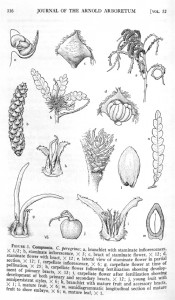Comptonia peregrina (L.) Coulter
Fragrant, suckering, deciduous shrub with deeply cut, fern-like pinnate leaves, male catkins and globular female flowers, followed by small ovoid fruits. To 1.2m. [RHSD, Hortus, Hilliers’].
Horticultural & Botanical History
‘A single extant species, Comptonia peregrina (L.) Coult., 2n = 32, sweet fern, found on poor, often rather dry soils in woodlands, clearings, pastures, and pine barrens from Nova Scotia to Saskatchewan, south to Virginia, western North Carolina (but also in four counties in the lower Piedmont), extreme western South Carolina, and locally in northern Georgia and Tennessee, Ohio, northwestern Indiana, Illinois and Minnesota. The rather attractive low shrub with its fragrant aroma when crushed has been separated into two varieties. The questionably distinct var. aspleniifolia (L.) Fern., of the Coastal Plain pinelands or pine barrens from Long Island, New York, to Virginia, is characterized by the minutely puberulent branchlets, sparsely short-puberulent or glabrous leaves, and fruits 3-4 mm. long. The more northern and inland var. peregrina has more or less pilose branchlets, pilose leaves, and fruits 4-5 mm long. […] Comptonia peregrina is the only survivor of a genus that had perhaps a dozen species in the Eocene and Oligocene. Berry (1906) postulated that Comptonia developed in the Upper Cretaceous as a branch from Myrica stock, but supporting evidence is lacking. Numerous Tertiary fossils of Comptonia clearly demonstrate that several species once occupied regions throughout much of the temperate world. In European Tertiary deposits, C. difformis (Sternh.) Berry is the most common fossil species of the genus (Kotlaba, 1967).’ [Journal of the Arnold Arboretum vol.52, p.317/1971].
Introduced to Britain in 1714. [JD].
History at Camden Park
Comptonia peregrina is marked with a ‘c’ in an 1836 edition of Loddiges’ catalogue held at Camden Park [CPA]. In William Macarthur’s code, used and explained elsewhere, this means grown at Camden. It is almost certain that it was grown in the gardens around this time but it did not appear in the catalogues.
Notes
Published Apr 02, 2010 - 02:00 PM | Last updated Apr 02, 2010 - 02:07 PM
| Family | Myricaceae |
|---|---|
| Category | |
| Region of origin | Eastern North America |
| Synonyms |
|
| Common Name | Sweet fern, Sweet bush, Sweet gale |
| Name in the Camden Park Record |
Comptonia aspleniifolia |
| Confidence level | high |


